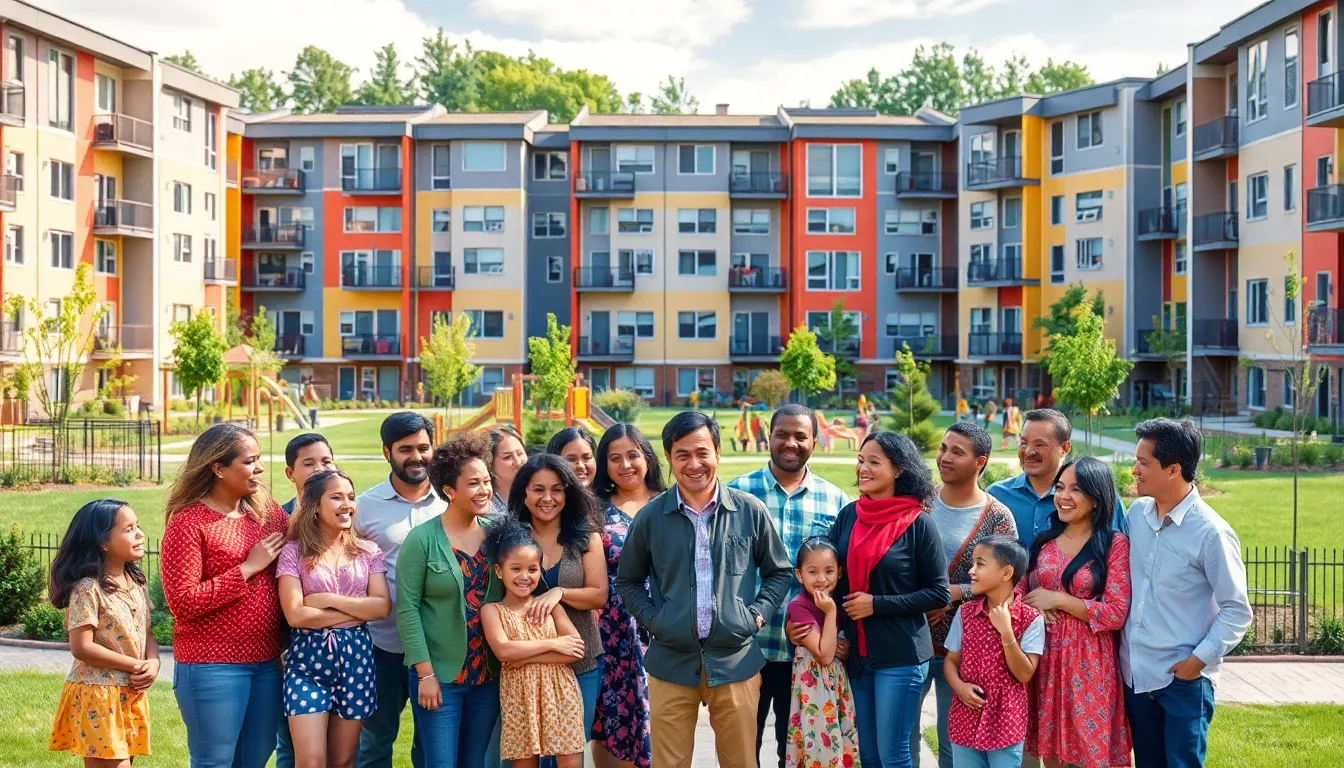Affordable housing isn’t just a buzzword thrown around at community meetings; it’s a lifeline for countless individuals and families. Imagine a world where everyone can find a cozy place to call home without sacrificing their morning coffee or weekend pizza night. That’s the dream, right? But what exactly does “affordable housing” mean?
In a nutshell, it’s housing that won’t leave you broke or living on ramen noodles. It’s about finding that sweet spot where rent meets income, ensuring people can live comfortably without financial stress. As cities grow and housing markets shift, understanding this definition becomes crucial for anyone navigating the complexities of modern living. Buckle up as we dive into the ins and outs of affordable housing, making sense of a term that impacts lives every day.
Table of Contents
ToggleUnderstanding Affordable Housing Definition
Affordable housing enables individuals and families to reside comfortably without experiencing financial hardship. It plays a crucial role in community stability and well-being.
Key Components of Affordable Housing
Key elements of affordable housing include income-based rent limits, availability of diverse housing types, and accessibility to essential services. Rent should ideally not exceed 30% of a household’s gross income. Various housing types such as apartments, single-family homes, and townhouses must exist within affordable housing frameworks. Accessibility to public transportation, healthcare, and educational facilities strengthens these communities. These components work together to create environments where residents can thrive financially and socially.
Importance of Affordable Housing
Affordable housing boosts economic security and fosters social equity. It allows families to allocate resources toward education, healthcare, and savings, leading to improved quality of life. Additionally, an adequate supply of affordable housing supports local economies by driving job growth and attracting businesses. Communities with accessible housing options tend to experience lower crime rates and healthier populations. Recognizing the significance of affordable housing is vital for addressing urban housing challenges and enhancing community well-being.
Types of Affordable Housing

Affordable housing encompasses several types, ensuring diverse options for individuals and families. Understanding these types clarifies how they contribute to community stability.
Public Housing
Public housing refers to government-owned residential complexes designed for low-income residents. Typically, units offer rent at rates aligned with tenants’ income, often below the market average. The U.S. Department of Housing and Urban Development oversees these programs, ensuring compliance with housing standards. Residents usually face eligibility criteria based on income and family size, promoting equitable access. Public housing plays a vital role in providing stable living conditions, fostering community engagement, and combating homelessness.
Subsidized Housing
Subsidized housing involves private or nonprofit properties supported by government financial assistance. Various programs, such as Section 8, offer rental subsidies to help tenants afford housing that meets quality standards. Landlords receive vouchers, making it possible to keep rent lower while ensuring properties maintain proper upkeep. Eligibility often depends on income limits, which vary by region. Such housing options remain critical for promoting affordability and enhancing residents’ overall quality of life.
Challenges in Affordable Housing
Affordable housing faces numerous challenges that obstruct availability and accessibility. Understanding these barriers helps in addressing the issue effectively.
Economic Barriers
Economic barriers severely limit access to affordable housing. Rising property values in urban areas lead to increased rent costs, driving low-income families out of desirable neighborhoods. Insufficient wages hinder residents from affording housing that meets their needs, forcing them into substandard living conditions. Housing supply remains insufficient compared to demand, contributing to the affordability crisis. Increased construction costs further impede developers from building affordable options, and competition for limited resources drives prices higher. In many cases, financial strain results in long commutes for jobs, exacerbating economic disparity.
Policy Issues
Policy issues often contribute to the challenges surrounding affordable housing. Zoning regulations in various regions restrict the development of new housing projects, limiting supply. Many local governments face pressure to maintain property values, which can lead to opposition against new affordable housing initiatives. Land-use policies frequently prioritize single-family homes over multifamily dwellings, impeding diversity in housing options. Additionally, inconsistent funding for federal and state programs affects the availability of affordable housing, leaving significant gaps in support for low-income families. Advocacy efforts play an essential role in influencing policy changes that promote affordable housing solutions.
Benefits of Affordable Housing
Affordable housing offers numerous benefits that positively impact individuals and communities. Understanding these advantages is crucial for addressing urban challenges and enhancing overall well-being.
Community Development
Community development flourishes with a robust supply of affordable housing. Residents gain access to stable living conditions, fostering community engagement and involvement. Diverse housing options promote inclusivity and empower residents to establish lasting connections. Accessible neighborhoods support social cohesion by enabling families to participate in community activities and events. Transformations occur when affordable housing integrates with essential services, such as schools and healthcare facilities, leading to increased overall quality of life. The presence of affordable housing often attracts local businesses, driving economic growth and enhancing community vibrancy.
Economic Stability
Economic stability is significantly enhanced in environments rich with affordable housing. Families allocate more resources to essential needs, such as education and healthcare, rather than being burdened by excessive housing costs. When housing costs remain under 30% of a household’s gross income, residents experience reduced financial stress and improved mental well-being. Stable housing further encourages long-term employment, as individuals feel secure in their living situations. Increased disposable income stimulates local economies, as families spend more on goods and services. Overall, affordable housing serves as a foundation for economic resilience, benefiting both individuals and the broader community.
Affordable housing is more than just a roof over one’s head. It’s a critical element that shapes the quality of life for individuals and families. By ensuring that housing costs remain manageable, communities can thrive, fostering economic stability and social equity. The ongoing challenges in the housing market underscore the need for continued advocacy and innovative solutions. As awareness grows, the push for policies that support affordable housing becomes essential for creating vibrant and inclusive neighborhoods. Ultimately, investing in affordable housing is an investment in the future of communities and their residents.





